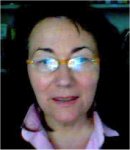|
|
Plenary
Lecture
Studies on a Promising Anticancer Molecule of Marine
Origin. Results of an Interdisciplinary Study

Professor Carla Falugi
Universita di Genova - Dipartimento di Biologia
Laboratory of Experimental Embryology and Cytotoxicology
Viale Benedetto XV, N°5 - I-16132 Genova, Italy
E-mail: falugi@unige.it
Abstract: Since the first
‘80s, we found that some tumour
types present over expression of
cholinesterase activities, and in
particular of acetylcholinesterase
(AChE, E.C: 3.1.17).
AChE is an enzyme associated to
the cholinergic signal system,
whose classic role is to remove
acetylcholine (ACh) from the
receptors. Nevertheless, the
protein is also involved in
cell-to-cell communication driving
embryonic development, by
mechanisms yet largely unknown,
possibly related to the
intracellular dynamics evoked by
ACh signalling, and in
morphogenetic cell movements,
related to AChE function as a
cell-substrate adhesion molecule
(SAM), through the affinity for
laminin. Moreover, this molecule
is affected by a number of natural
and synthetic inhibitors,
including environmental
contaminants. For this reason, the
activity of AChE was found to be a
good biomarker for environmental
toxicity, related to the role
played by ACh in inflammation.
During studies on environmental
toxicants, such as organophosphate
pesticides, we found that a low
AChE inhibition promotes apoptosis
in human cultured cells, and
decreases cell movements, causing
embryonic anomalies such as cardia
bifida in chick embryos. Apoptosis
is one of the good cell responses
against tumour, and preventing
cells migration is a bad feature
for embryonic development, but a
good feature for metastasis
spreading prevention.
In particular, Non Small Cell Lung
Cancer (NSCLC) biopsies and
cultured cell lines present
enhanced AChE activity, and
possess a complete set of
molecules related to cholinergic
signal system, including vesicular
ACh transporter, ACh biosynthetic
enzyme, and receptors. Thus, our
hypothesis was that
down-regulation of this signalling
system, in a natural-like and
non-toxic way would help in
enhancing anti-cancer cell
features.
A natural anti-AChE complex
compound, belonging to the class
of polymeric alkylpyridinium salts
(poly-APS), is produced by the
Mediterranean sponge, Reinera
sarai, to avoid infestation from
other marine organisms. Poly-APS
were found to be a mixture of two
of 3-octylpyridinium polymers,
including 29 and 99 monomeric
units, and were demonstrated to
exert strong AChE-inhibitory
activity in vitro. Colleagues of
the CNR-ISMAR demonstrated the
neurotransmitter/neuromodulator
role of AChE in living organisms
and the non toxic and reversible
activity of poly-APS. This
confirmed the requested features
of the compound, that was used on
NSCLC cells for a preliminary
battery of tests, in order to
check selective apoptosis among
NSCLC and healthy cells.
On exposure to low poly-APS doses,
a high percentage of the cancer
cells underwent apoptosis, in a
significant amount vs normal
lymphocytes, used as a healthy
control (P<0.05). Then, a complex
series of experiments was begun,
both in vitro and in vivo, in
cooperation with the Institute for
the Study of cancer (IST), who
supplied cells and operated on
mice for pre-clinical experiments.
In living mice, the low toxicity
of poly-APS on normal cells was
confirmed by injection in the
caudal vein. No overt effects on
health parameters, such as weight
gain and physical behaviour, were
observed, and histological
analysis of major organs did not
reveal differences between the
treated animals as compared to
controls. A series of synthetic
homologs of poly-APS molecules
were performed and tested, in
order to choose the more promising
substances to be used for further
pre-clinical experiments. The
results of this work are the
object of this presentation.
Brief Biography of the Speaker:
Carla Falugi, born in Seggiano (GR)
12/10 1943, is full professor
since 1999; graduated in Natural
Science, the 21st November 1968,
with thesis evaluation 110/110,
performed didactic and research
tasks since 1970 (MPI grant for
didactic and scientific training
up to 1972; MPI research contract
up to 1976; assistant professor
since 1977; professor with
didactic charge of Comparative
Anatomy from 1977 to 1983)
After 1983, she was teacher of
Cytology and Histology;
Experimental Embryology and
Morphology, Developmental Biology.
At present she teaches 4 courses:
Developmental Biology (since
1990); Cytotoxicology;
Environemntal Toxicology and
Biomarkers of environmental
damage.
Her research, since 1970, regards
the functions of signal molecules,
belonging to the cholinergic
neurotransmitter system, and their
receptors in regulation of
cell-to-cell and cell-environment
communication promoting
differentiation (induction, ion
flux, membrane depolarisation
etc.)during early developmental
stages, from fertilisation. The
model mainly used for this basic
study has been represented by
marine invertebrates, and in
particular embryonic and larval
development of sea urchin up to
metamorphosis and juvenile stages.
This model has been found very
sensitive to environment
interaction. In the latest years,
the interst on neurogenesis and
neural functioning was carried out
by the use of two human in vitro
models: the NTERA2 cells (classic
and well known neurogenic model)
able to differentiate towards
cholinergic neurons and
olygodendrocyte co-culture, and
preadipocyte from lipoaspirate
primary cultures, appropriately
differentiated towards hMADS
(human Multipotent Adipose-Derived
Stem cells). These two models
offer a tool system to investigate
cell differentiation/functioning
in a manner pertinent to
embryogenesis, that also retain
interactions between glial cells
and neurons.
Based on this experience. Since
1987 she has undergone a study on
the effects of xenobiotics, able
to interact in the correct
reception of signal molecules, in
order to establish the effects of
these substances on correct
embryonic development and cell
differentiation and at the same
time to select alternative models,
to use for obtaining biomarkers of
environmental state. In this
context, she is member of the
Italian Platform for Alternative
Models (IPAM).
|
|
